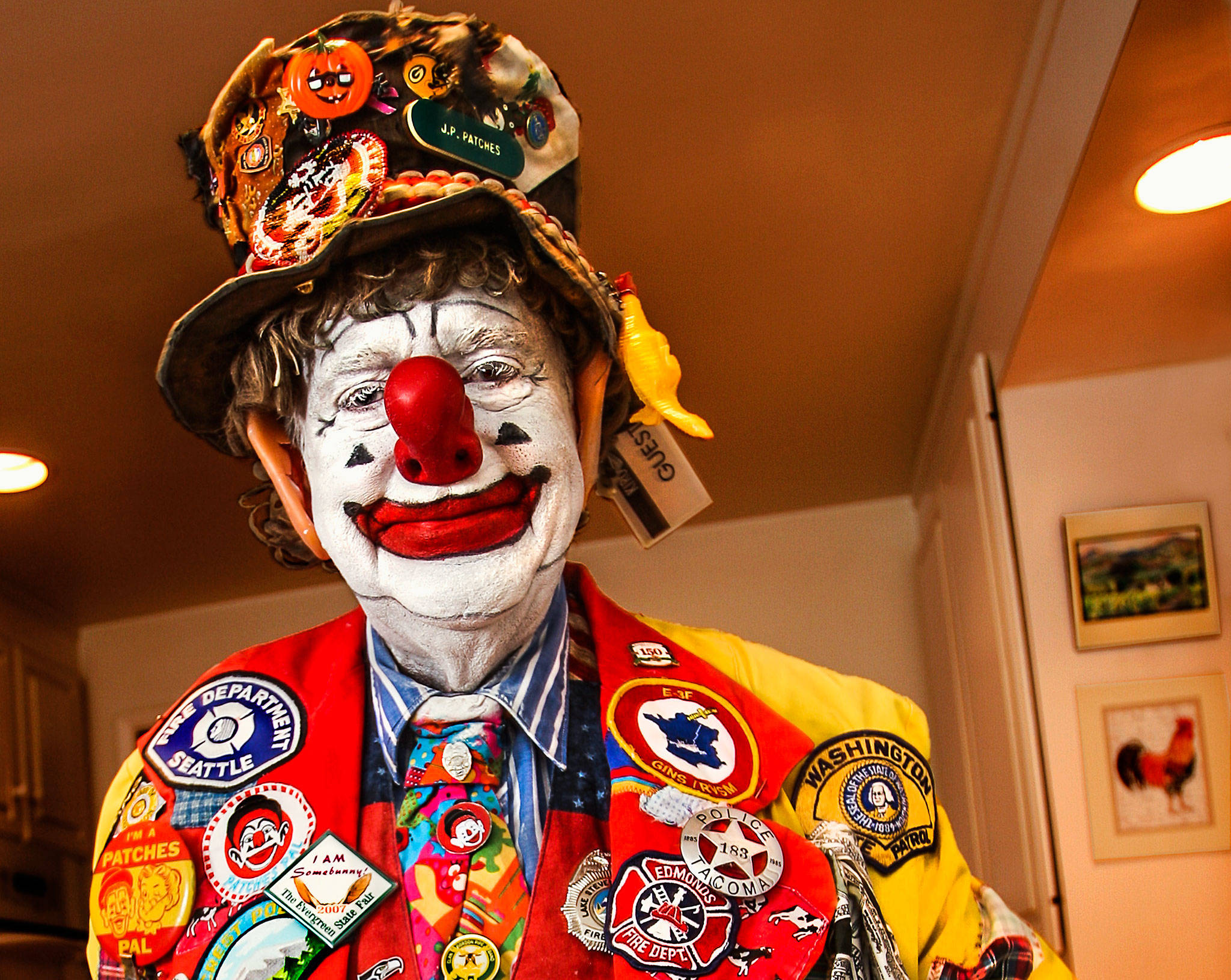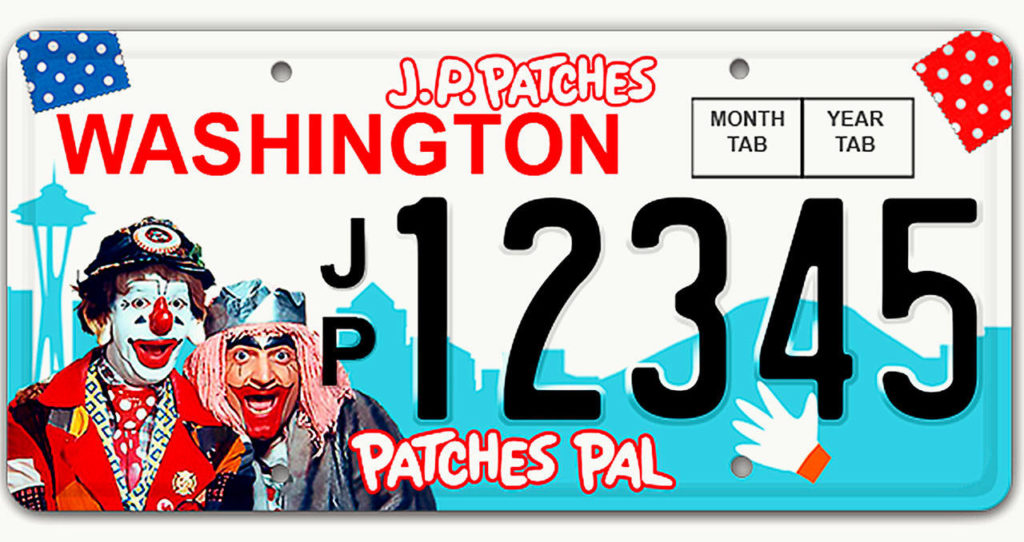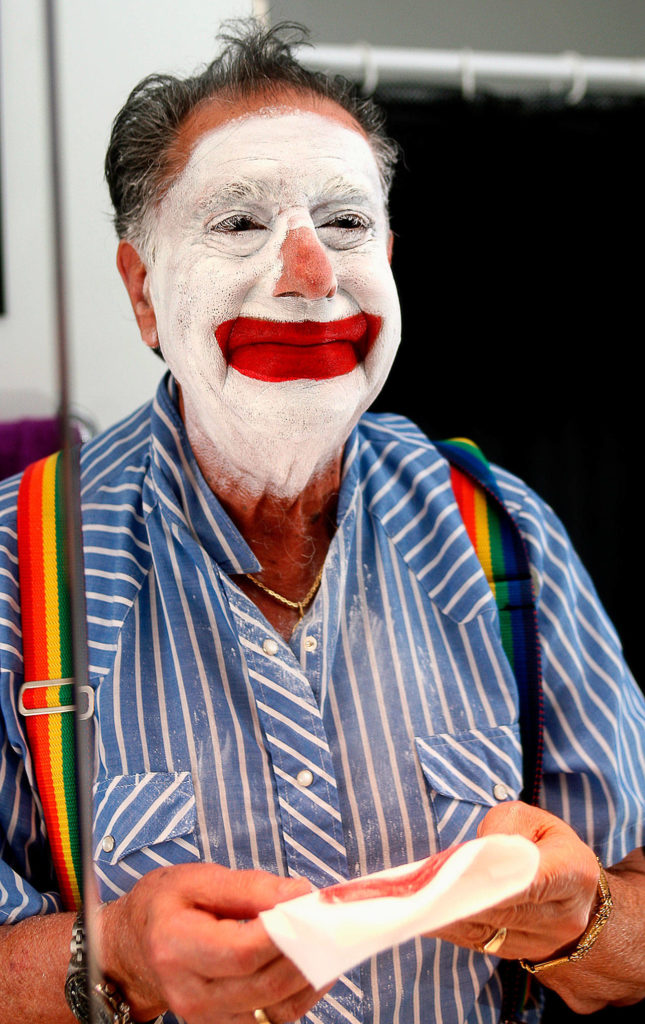Sometime later this year, while stuck in traffic, you might find yourself grinning at a pair of unforgettable faces. Reading a license plate ahead of you — “JP” and “Patches Pal” — memories of a zany, much-loved clown and of your own childhood could come flooding back.
“He was about the most consistent thing in little kids’ lives outside their parents — and for a lot of kids, more consistent than their parent,” said Bryan Johnston, author of the 2003 book “J.P. Patches: Northwest Icon.”
Making its way though the Legislature is House Bill 1255. If passed, it will create a Patches Pal special license plate honoring the memory of Julius Pierpont Patches. The local TV clown and mayor of the “city dump” was played for decades by Chris Wedes of Edmonds. Wedes was 84 when he died in 2012. He had battled a type of blood cancer.
The Emmy-winning “J.P. Patches Show” aired on Seattle’s KIRO-TV from Feb. 10, 1958, to Sept. 21, 1981. More than awards, J.P. and his sidekick “girlfriend” Gertrude, played by Bob Newman, won children’s hearts.
“I’ve got J.P. stuff all over the house,” said Bob Bolerjack, the city of Everett’s director of government affairs and a former Herald editor. “It was such a communal experience. There were only four channels, all the kids were watching the same thing. He had a gentle sense of fairly sophisticated humor.”
Bolerjack celebrated his 8th birthday on the show. In 1997, his mom arranged for J.P. Patches to show up at his 40th birthday party. When his son Randy Bolerjack turned 2, he was taken to a J.P. public appearance in Mill Creek wearing the same Patches jacket his father Bob had as a 2-year-old.
Both J.P. and Gertrude are pictured on the license plate, which was discussed at a House Transportation Committee hearing Jan. 31 and by a Senate committee this week. The bill is sponsored by Rep. John Lovick, a Mill Creek Democrat.
Lovick garnered laughs at the January hearing when Rep. Jake Fey, head of the House Transportation Committee, asked in jest, “Are you saying it was your kids who were watching the show?”
“I would watch with the kids all the time,” Lovick said Thursday. The 44th District lawmaker hopes to get a J.P. license plate. If approved, the bill would take effect Oct. 1.
There are dozens of special plates available, and more proposed this session, including one highlighting the state’s wine industry.
A Patches Pals license plate organizing committee raised more than $7,000 and gathered at least 3,500 signatures, both needed for the application process. Proceeds from sales would support Seattle Children’s Hospital’s Strong Against Cancer, a nonprofit that helps fund research and clinical trials.
The license plate wouldn’t be the first visible tribute to J.P. Patches.
In 2008, Wedes was in Seattle’s Fremont neighborhood for the unveiling of bronze statues of J.P. and Gertrude, titled “Late for the Interurban.” Created by Sultan sculptor Kevin Pettelle, it’s near the “Waiting for the Interurban” sculpture.
Johnston, 56, worked on the effort to have the statue installed. He said he was “absolutely” a Patches Pal. He grew up in Lake Forest Park, where he still lives.
“He raised an entire generation,” said Johnston, a longtime TV and video writer and producer. He first met Wedes when, just out of college, he worked at KIRO’s cafeteria. Years later, he saw J.P. at a parade and introduced himself.
Johnston hired Wedes to appear as J.P. at his 20th high school reunion. “That was a big hit,” said Johnston, a 1980 graduate of Shorecrest High.
While working at KOMO-TV, Johnston contacted Wedes and asked to write a book about him. “He always said, ‘Who would want to read it?’ We sold every copy that was printed, more than 15,000,” Johnston said.
In interviews with Wedes, Johnston heard wacky stories about the show’s heyday. It was live TV, and Wedes and Newman improvised the plots. “They had no script,” Johnston said. Newman, he said, now lives at a senior community in Shoreline.
At 62, Carl Lovgren, of Edmonds, is also part of the Patches demographic. He grew up on Seattle’s Queen Anne Hill, near KIRO’s studio, and recalls trying to catch a glimpse of the clown. “My Cub Scout group was probably on J.P. a couple times,” said Lovgren, who also worked on the statue project.
As a carpenter who did some work at Wedes’ Edmonds home, Lovgren got to know him and became a driver who took J.P. to public events. At home, Wedes “would treat you like you were related,” Lovgren said. “He’d show you pictures. If he had soup on, you got soup.”
Thinking about the enduring magic of J.P., Lovgren said, “he was very personal to all the kids. We could all relate to the antics — how fun it was.”
“He taught us lessons as well. I do kind of feel for kids nowadays. They don’t have that type of entertainment,” Lovgren said.
Wedes and his sidekick “did what they thought was funny,” Johnston said. “Kids know what’s authentic. They were authentic. They were just funny dudes.”
Julie Muhlstein: 425-339-3460; jmuhlstein@heraldnet.com.
Talk to us
> Give us your news tips.
> Send us a letter to the editor.
> More Herald contact information.




























